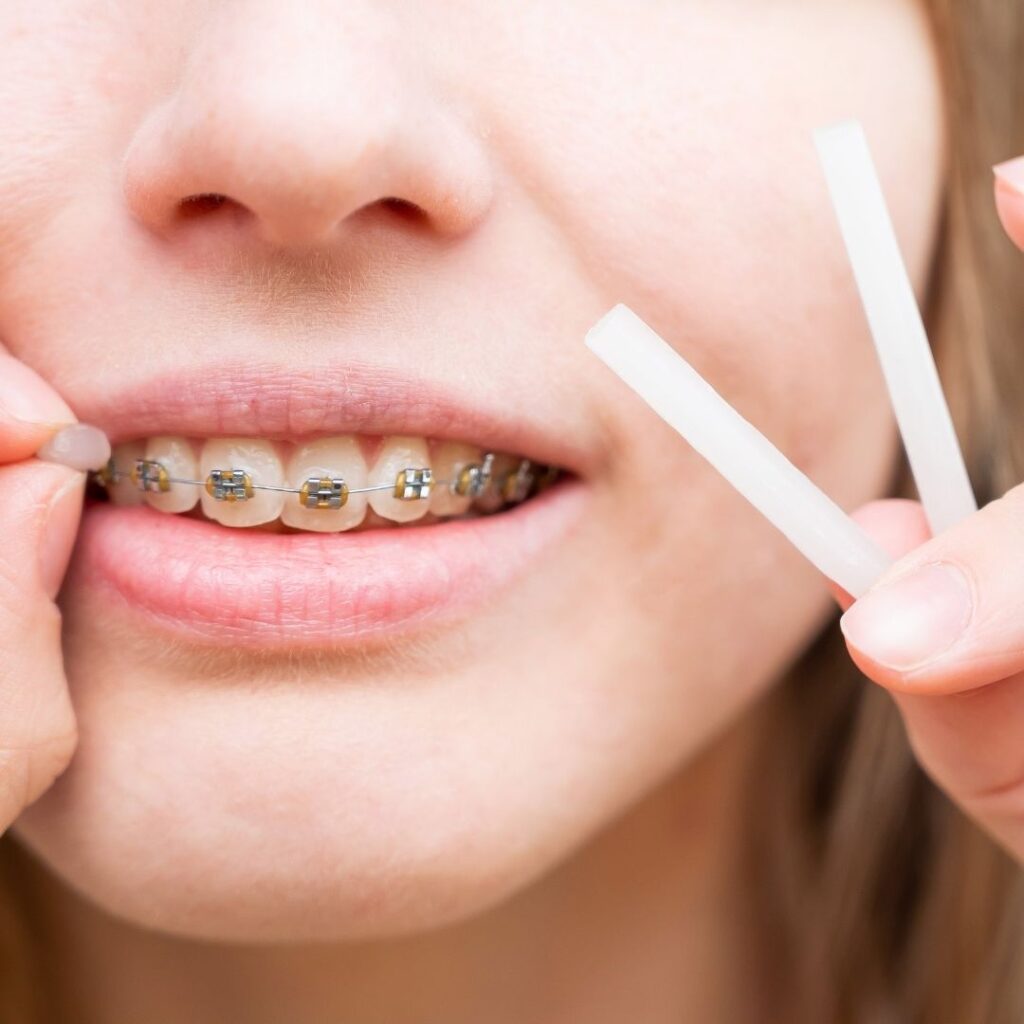Braces have many disadvantages, and even though I’m an orthodontist, I wanted to address a question I get asked often: ” Why are braces bad for you?”
Orthodontic brackets have been used for over one hundred years. Millions of patients have had braces, and I have personally put over 10,000 brackets on various patients.
That being said, there are still many reasons why braces are bad for you. Let me give you the top 3 reasons why braces are bad for you and how to mitigate any possible issues.
1. Braces cut your gums and cheeks
I had braces in my early twenties. Although over fifteen years ago, I can still remember getting braces put on and the whole journey.
One of the most challenging parts of having braces is the constant irritation they can bring.
Many patients will complain about pinching or poking wires and brackets. Poking can be an ongoing issue for some and has caused a few patients to stop treatment.
Most patients don’t have any issues with this, but some sensitive patients can develop sores in their mouths from the constant rubbing.
When I had braces, I had to cut the wire myself before I had the proper tools! It was a pain because my orthodontist’s office was over 30 minutes away, so I couldn’t just go in for a bit of clipwire or have them check my brackets.
2. Braces can lead to gingivitis and bone loss
In our practice, roughly 60% of the patients are younger than 18 years old. As many dentists can tell you, kids do not have excellent hygiene.
Many parents struggle to get their children to brush, let alone floss. In my experience, roughly 20% of kids with braces floss regularly.
Brushing and flossing without braces is tough enough for adolescents, but it gets nearly impossible when you add braces on top of that.
If a child is an average to below-average brusher, then they will have some serious issues with braces. Braces cover the front (facial) surface of the teeth and make brushing more difficult.
If you do not brush and floss properly, you will get gingivitis (inflammation of the gums), leading to periodontitis (inflammation of the tooth ligaments) and bone loss.
Gingivitis is reversible, but it does not look good. Many patients will complain of “puffy gums” which is gingivitis. We let them know the condition is reversible, but we cannot cure it for them.
Gingivitis is a disease that can only be cured by proper oral hygiene. There are even times when we need to remove the wire or braces so the patient can get healthy again.
3. Braces can cause white spots.
White spots are one of the worst possible outcomes of braces. Decalcification is embarrassing and may never go away.
White spot lesions are caused by poor oral hygiene, which can be exacerbated by having braces on your teeth.
As mentioned previously, brushing with braces on your teeth is more difficult. Some braces are so large that they take up the majority of the facial surface of the teeth. Brushing around your braces can become time-consuming and challenging.
If you cannot remove all of the food debris from your mouth, bacteria will eventually break down the food and cause an acidic environment.
This acidic environment can break down the teeth and cause cavities and white spots. The white spots or squares typically surround the braces but not under the braces. The reason the white spots do not form under the brackets is that the composite glue we used to bond the brackets protects the teeth.
If you do not brush and floss properly with braces, the permanent white spot lesions can give you an odd-looking smile for the rest of your life.
How can I prevent the negative effects of braces?
Alright, now that I’ve scared you into thinking braces are horrible, let me tell you the straightforward ways to prevent any of these harmful consequences.
1. Use orthodontic wax

Orthodontic wax is a lifesaver! We give it to every patient and explain how to use it.
Typically, wires or brackets will rub your teeth for a while until you get used to the braces. If any part of your braces is irritating and causing discomfort, you can take a little piece of wax and add it to the area causing the pain.
Wax will alleviate 90% of the poking issues and is a very easy fix. If you have a wire that is poking and wax is not helping, then head into your orthodontist’s office and have them cut the wire. This is typically a very fast appointment and can be handled at any part of the day.
If you cannot get into your office and the wire is small enough, sometimes you can cut the orthodontic wire with a nail clipper or a wire cutter (which I don’t necessarily recommend).
2. Brush regularly with an automatic toothbrush
If you have a manual toothbrush throw it out right now and go buy an electric toothbrush. There are many good options for electric toothbrushes, but our favorite is our “Thrive Sonic Toothbrush” or a Sonicare.
I do not know a single dentist who uses a manual toothbrush. Automatic toothbrushes clean your teeth better than any manual toothbrush can.
Investing in a good automatic toothbrush will cost you $50-$200 but will save you thousands in unnecessary dental services.
Automatic toothbrushes help prevent dental disease and whiten teeth. They are so readily available today in North America that there is virtually no reason anyone should not have one.
There are multiple tools to make flossing easier with braces. Specialized flossers called “packers ” make flossing a breeze with braces.
If you truly do not want to floss, you can try a Waterpik, but THIS IS NOT AS GOOD AS FLOSSING. A Waterpik is more expensive and less effective than floss. A Waterpiks only advantage is that it is easier than flossing.
I floss every night because my teeth feel so dirty if I don’t. I’m not an expert flosser, but it takes me less than 30 seconds to floss my teeth. My wife is more particular, and it takes her double or triple the time, but in the end, flossing doesn’t have to be such a big chore. That 30-90 seconds a night will prevent the need for deep scaling and root planing.
In dentistry, there is a saying that you should “only floss the teeth you want to keep.” Without proper flossing, you only clean roughly 60% of your tooth surface so just think about that. Would you only clean 60% of your body?
3. Invest in some fluoride mouthwash
When I had braces, I was in dental school. We went to a conference, and someone there told me I should be rinsing with fluoride mouthwash.
I wasn’t thinking about it then, but it was that final layer of protection for my teeth. I became a good brusher and flosser but adding a fluoride mouthwash such as “ACT mouthwash” helped protect my teeth from white spots.
If you brush and floss correctly, there is a minimal chance you will get any white spots when removing your braces, but adding a good mouthwash is the “cherry on top.” Proper oral hygiene will ensure your teeth are correctly mineralized and protected from decay and decalcification.
White spot lesions do not happen overnight, and any orthodontist can tell months in advance that oral hygiene is an issue and that white spots may occur.
It still surprises me how many patients do not care that their hygiene is so poor, and they may get white spot lesions.
If you are reading this and wondering about those white spots after braces, you are likely a great patient who cares about their oral health. If you care about your oral health and do everything mentioned in this article, your teeth should be protected from that type of staining.
Conclusion
Braces can be bad for you if you are not prepared to care for them properly. You can develop mouth sores, gingivitis, and white spots from braces.
Multiple ways exist to prevent the negative side effects of braces, such as using orthodontic wax, brushing with an electric toothbrush, and using specialized mouthwash to protect teeth from damage.
If you want that smile you deserve, protect your teeth and create an excellent oral health environment.
I look forward to meeting you and helping you along your orthodontic journey!



